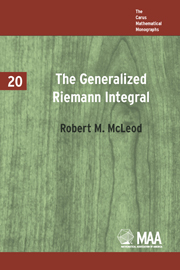Book contents
- Frontmatter
- PREFACE
- LIST OF SYMBOLS
- Contents
- INTRODUCTION
- CHAPTER 1 DEFINITION OF THE GENERALIZED RIEMANN INTEGRAL
- CHAPTER 2 BASIC PROPERTIES OF THE INTEGRAL
- CHAPTER 3 ABSOLUTE INTEGRABILITY AND CONVERGENCE THEOREMS
- CHAPTER 4 INTEGRATION ON SUBSETS OF INTERVALS
- CHAPTER 5 MEASURABLE FUNCTIONS
- CHAPTER 6 MULTIPLE AND ITERATED INTEGRALS
- CHAPTER 7 INTEGRALS OF STIELTJES TYPE
- CHAPTER 8 COMPARISON OF INTEGRALS
- REFERENCES
- APPENDIX Solutions of In-text Exercises
- INDEX
CHAPTER 1 - DEFINITION OF THE GENERALIZED RIEMANN INTEGRAL
- Frontmatter
- PREFACE
- LIST OF SYMBOLS
- Contents
- INTRODUCTION
- CHAPTER 1 DEFINITION OF THE GENERALIZED RIEMANN INTEGRAL
- CHAPTER 2 BASIC PROPERTIES OF THE INTEGRAL
- CHAPTER 3 ABSOLUTE INTEGRABILITY AND CONVERGENCE THEOREMS
- CHAPTER 4 INTEGRATION ON SUBSETS OF INTERVALS
- CHAPTER 5 MEASURABLE FUNCTIONS
- CHAPTER 6 MULTIPLE AND ITERATED INTEGRALS
- CHAPTER 7 INTEGRALS OF STIELTJES TYPE
- CHAPTER 8 COMPARISON OF INTEGRALS
- REFERENCES
- APPENDIX Solutions of In-text Exercises
- INDEX
Summary
The first objective in Chapter 1 is to make plain what change is being made in the Riemann definition and to indicate why it should be beneficial. Then the definition of the generalized Riemann integral is formulated. It is given first for bounded intervals of real numbers and then, in the same language, for unbounded intervals. On the basis of these formulations the fundamental theorem of calculus linking integrals and derivatives is given an appealing form. Multiple integrals are defined, and again it is possible to use the same language as that first adopted for integration on a bounded real interval.
A more detailed description of the contents of Chapter 1 follows.
Section 1.1 begins by recalling the definition of the Riemann integral. Then it turns to the familiar problem of the approximation of the area of the region under a function graph and notes how the approximation could be done more effectively. That discussion leads to the crucial notion of a gauge. Several examples are worked out in detail to provide insight into the effective use of gauges. The section closes with the statement of a fact about gauges which is indispensable to the satisfactory use of gauges.
Section 1.2 opens with the context in which the definition will be placed. Then some notation for Riemann sums is introduced. At that point the formal definition of the generalized Riemann integral on a bounded interval of real numbers is brought in.
- Type
- Chapter
- Information
- The Generalized Riemann Integral , pp. 5 - 46Publisher: Mathematical Association of AmericaPrint publication year: 1980
- 1
- Cited by



